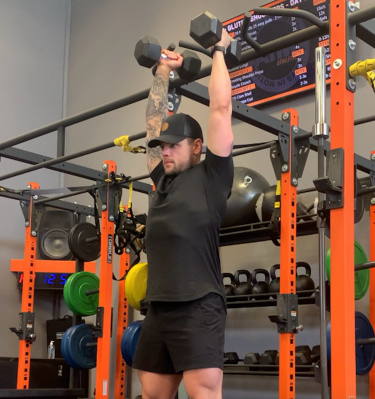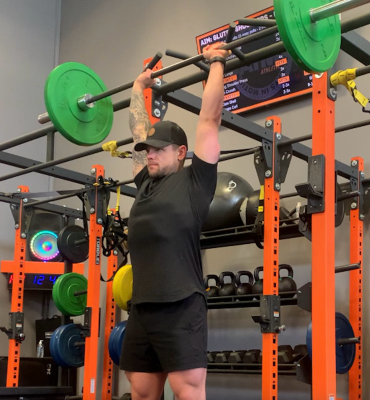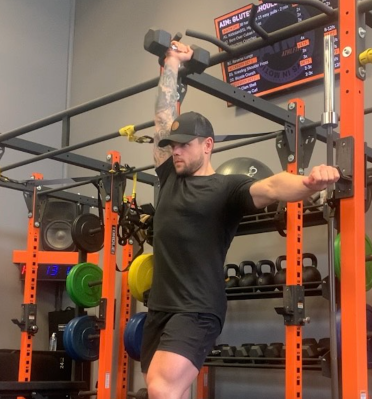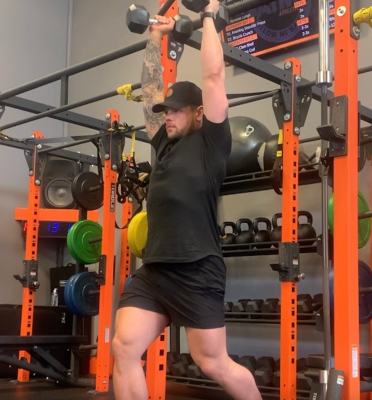An upper-body movement that makes a regular appearance in the strength circuits of CrossFitters and body-builders, the overhead press is a sound addition to the exercise routine of almost anyone who has their eyes (er, body) set on building strength, losing weight, or otherwise optimizing their overall health and well-being, according to certified strength and conditioning coach Jake Harcoff, CSCS, head coach and owner of AIM Athletic.
That’s because in addition to strengthening your upper body, the overhead press engages several other muscle groups, such as your core, glutes, and quads, he says, which makes it a full-body burner.
The thing is, you can’t just grab a weight and start slinging it toward the sky. Performing the overhead press requires some movement savvy. Executing the movement with sound form and correct weight is essential for reaping the potential benefits of the exercise and minimizing risk, Harcoff explains.
With that in mind, ahead you’ll find everything you need to know about the overhead press, including a step-by-step guide on how to do it safely, the muscle groups it works, safety tips, and more.
How to do an overhead press with perfect form
Using dumbbells is a great option for anyone who has mobility limitations with one or both shoulders, Harcoff says.
“Each arm is able to move independently of each other instead of being bound to the shape of the bar,” he explains. “Using dumbbells also challenges the stabilizing muscles around the shoulder joint more dynamically,” he says, which ultimately promotes better joint health long term and reduces the risk of injury.

- Stand with your feet hip-width apart and hold a dumbbell in each hand, arms at your sides. Your palms should be facing in toward your body.
- Lift the weights to your shoulders with your elbows bent at 90 degrees.
- Brace your core and engage lower body for stability. Exhale as you press both dumbbells directly over head, keeping your back tight and your wrists in line with your shoulders the entire time.
- Keep pressing until your arms are straight.
- Inhale as you return the dumbbells to start position. That’s one rep.
The overhead press muscles worked, explained
To the naked eye, the overhead press may look like just an upper-body strengthener. And sure, the overhead press primarily targets your top half, but most overhead press variations are actually full-body movements.
The act of pressing the weight overhead works your chest, shoulders, traps, and triceps, including all the stabilizing muscles in the rotator cuff and the wrists, according to Harcoff.
“You also call on various core muscles including the rectus abdominis and obliques to maintain proper upright posture and spinal alignment throughout the movement while you are standing,” he says. Your core will also have to activate if you are performing a seated variation of the movement on a bench without a back.
All the overhead press benefits that’ll convince you to try it
The overhead press is a full-body movement that, when performed properly, can improve your quality of life as well as capacity during other strength movements. Specifics, ahead.
1. It supports shoulder health
Your shoulders are a finicky body-part. Need proof? An estimated that 20 percent of the population will experience shoulder pain in their lifetime, according to Beacon Orthopaedics & Sports Medicine.
Obviously, there’s no way to totally injury-proof any part of your body. But as far as the shoulder goes, “generally the stronger the shoulder muscles are, the stronger the shoulder joint is,” says physical therapist Grayson Wickham, DPT, CSCS, founder of digital movement platform Movement Vault. “And the stronger the shoulder joint is, the lower the risk it is for accruing injury.”
Assuming someone has adequate shoulder mobility to execute the overhead press safely (more on this ahead) and is properly weighting the exercise, the movement excels at strengthening all the muscles in the fussy joint, he says.
2. It increases strength, head-to-toe
Sometimes called the shoulder press, you might be surprised to learn that the overhead press works far more muscle groups than just those in your shoulder. Staying stable while you press the weight overhead requires you to activate your midline, as well as big and small players in your legs, Wickham says.
3. It boosts balance big time
Both holding the weight in front of your body (the start position) and pressing the weight on your head require your core muscles to tap in, Harcoff says. In particular, the rectus abdominis, obliques, and transverse abdominis are called on to help you maintain sound form, he says.
While core muscles are often regarded as mirror-muscles, having a strong core helps improve your overall quality of life in and out of the gym.
“The midline is the epicenter for the body,” Wickham says. “When this epicenter is well-trained and strong, it helps you stay safe when doing anything from picking up a package to getting on your tip-toes to get something from the top shelf,” he says.
A strong core also helps you throw and kick more powerful during field sports, and relieve lower back pain, he says.
4. It improves posture
This shoulder exercise strengthens the three main muscle-groups responsible for sound posture: The shoulders, upper back, and core.
Rounded shoulders are typically caused when an individual does not have the shoulder or upper back strength necessary to pull the upper body into an upright position, Wickham says. Meanwhile, a sagging middle back, which can accentuate rounded shoulders, is caused by a weak midline, he says.
Essentially any exercise routine that involves improved back, shoulder or midline strength can help counteract poor posture over time, Wickham says. (In particular, when combined with chest-opening stretches). The overhead barbell press, however, allows an individual to strengthen all three muscle groups at once, making it a super efficient addition for ditching the droop.
5. It has carryover to other movements
No matter your specific fitness goals or workout regime, a weekly or biweekly overhead press session can help you get there.
The movement will increase comfort with having weight overhead, Wickham says, which comes in handy for other exercises such as the overhead squat, snatch, clean and jerk, overhead lunge, and overhead carry.
Further, because the exercise strengthens your pushing muscles—i.e. the chests, triceps, and shoulders—you’ll see improvements in your ability to perform movements such as a bench press, push-up, handstand push-up, dips, and muscle-ups, he says.
“Generally the stronger the shoulder muscles are, the stronger the shoulder joint is. And the stronger the shoulder joint is, the lower the risk it is for accruing injury.” —Grayson Wickham, DPT, CSCS
The best overhead press variations to spice things up
No doubt, the standard overhead press is a great movement but there other overhead press variations you can do to kick things up a notch in the name of even greater gains.
1. Barbell overhead press
The standing overhead barbell press utilizes muscles of the lower body, including the glutes, quadriceps, and hamstrings, Harcoff says. “These all contribute to creating a stable base for you while you do the movement,” he says. Even your foot muscles have to turn on during standing variations of the overhead press in order to keep you steady while you work.

- Load the barbell into a power rack, J-cups positioned so that the barbell is at chest height.
- Unrack the bar by positioning your hands just outside of your shoulders, and rotating your elbows under the bar and away from your body.
- With the bar in the front-rack position, step away from the rack so that feet are hips-width.
- Think about pulling the top part of your rib-cage down to the floor to activate your midline. Ground your feet into the floor, squeeze glutes, and pull-up on quads for extra stability.
- Press the barbell straight overhead. As the bar nears face, tilt head back and continue pushing the bar directly up. Once the bar has passed your face, return your neck to neutral position.
- Continue pressing until your arms are locked out overhead, with your wrists stacked directly above your shoulders.
- Use your lats to pull the barbell back down, inhaling as you return the weight to the front-rack position. That’s one rep.
Note: In the event that you don’t have a rig or squat rack to set the barbell up in, you can also power or squat clean the barbell from the floor. Alternatively, you can do the dumbbell overhead press above.
2. Single-arm dumbbell overhead press
Whether you only have one dumbbell on tap or are super into building midline strength, give the single arm dumbbell overhead press a whirl. A unilateral version of the overhead press, this exercise allows you to strengthen each side of your body separately. “Because you’re only weighted on one side, your side obliques have to work overtime to keep your body steady while you press weight up on just the one side,” Wickham says.
Just be sure to select a weight you can physically lift with sound form with each side. Wickham explains: Unless you’re fully ambidextrous, odds are that you will be slightly stronger on one side than the other. A lil strength differential between sides okay, he says, but if the imbalance is too pronounced it puts you at increased risk for overcompensation injuries and poor posture.
You only ever want to lift as much as you can on the weaker side as lifting more weight with the stronger side will continue to exacerbate strength differences. The good news is that the weaker side will get stronger when it’s forced to work independently, he says.

- Stand with your feet hip-width apart and hold a dumbbell in your right hand, arms at your sides. Your palms should be facing in toward your body.
- Lift the weight to your shoulder with your elbow bent at 90 degrees.
- Brace your core and engage lower body for stability. Exhale as you press the dumbbell directly over head, keeping your back tight and your wrists in line with your shoulders the entire time.
- Keep pressing until your right arm is straight.
- Inhale as you return the dumbbell to start position. That’s one rep.
- Repeat for the desired number of reps and then repeat on the opposite side.
3. Overhead press from split jerk position
Split jerk may sound like an R-rated dance move, but it’s actually an Olympic weightlifting movement that involves “catching” the barbell overhead in a lunge position. Well, the overheard press from the split position involves getting into a jerk (lunge) stance and then pressing the weight directly overhead, Wickham explains.
As you might guess, this movement is a higher skill movement compared to other overhead press variations. However, for individuals who are comfortable with a barbell—powerlifters, CrossFit athletes, Olympic lifting competitors, etc.— Harcoff says it’s a great add-in.
Strict pressing from this split-legged position increases the demand on your core “as the body must resist lateral movement and maintain balance throughout the movement,” he explains. “This heightened core engagement not only strengthens the abdominal but also targets the oblique muscles to improve overall stability and control.”

- Stand with your feet hip-width apart and hold a dumbbell in each hand, arms at your sides. Your palms should be facing in toward your body.
- Lift the weights to your shoulders with your elbows bent at 90 degrees.
- Then, step into a lunge position, with your front knee bent and your back leg hovering above the ground.
- Brace your core and engage lower body for stability. Exhale as you press both dumbbells directly over head, keeping your back tight and your wrists in line with your shoulders the entire time.
- Keep pressing until your arms are straight.
- Inhale as you return the dumbbells to start position. That’s one rep.
The most common overhead press mistake—and how to fix it
Often, when people are doing the overhead press incorrectly, it isn’t because their set-up is flawed or they don’t understand the mechanics of the movement. Instead, it is because they lack the prerequisite shoulder or thoracic spine mobility to do the movement correctly, according to Wickham.
If your shoulder complex or T-spine lacks mobility—due to pre-existing injury, lack of use, or limited body positions throughout your day—you’ll likely still be able to get the weight overhead, he says. Unfortunately, to do so, your body will force on the surrounding joints and muscles to do the work instead. Usually, it’s your lower back that will end up compensating for lack of mobility in these areas, Harcoff says.
The rub? “This compensation leads to increased risk of injury for the compensating joints down the line,” Wickham says. Indeed, a herniated disc, lower back strain, elbow dislocation, and generalized pain are all possible, he says. Not ideal for anyone, let alone someone looking to improve overall strength and performance!
Plus, when you don’t have the mobility to perform the exercise properly, the compensations your body automatically employs actually reduce the work that your shoulders and midline have to do, which makes the exercise less effective at strengthening the muscles you’re targeting. Sigh.
Your move: Make sure you have adequate mobility before trying the overhead press. You can assess this by standing against a wall, or lying down, and attempting to fully flex your arms overhead, Harcoff says. Can you do so without arching your lower back excessively or compensating by pushing the head forward? If so, you probably have solid shoulder and T-spine mobility.
If mobility deficits are observed during this test, Harcoff suggests incorporating specific stretches that target the shoulder restrictions, such as shoulder dislocations using resistance band, PVC pipe figure 8s, and wall angels.
“Arm circles, the ‘thread the needle’ stretch, cross-body shoulder stretches, and doorway stretches are also good options,” says exercise physiologist and certified strength and conditioning coach Sharon Gam PhD, CSCS. You should also incorporate thoracic spine stretches such as thoracic extensions over a foam roller and cat-cow stretches, Harcoff says.
“While addressing mobility limitations, you can integrate other shoulder-strengthening exercises that don’t demand quite as much mobility,” Harcoff says. “Exercises like the lateral raise, front raise, bent-over lateral raises, and face pulls will help you strengthen your shoulder muscles while you prepare for more complex movements like the overhead press,” he says.
When you graduate to overhead pressing movement, Gam recommends trying out the landmine press first before jumping straight into the overhead shoulder press. “It allows you to overhead press at a less vertical angle, which means it may be a more accessible exercise,” she says.
Safety tips to consider when performing the overhead press
For individuals who meet the movement’s pre-requisite mobility demands, the overhead press is generally pretty safe exercise. Still, there are some things you should keep in mind to protect the health of your muscles, as well as your body as a whole.
1. Get the green light from a fitness and/or healthcare pro
If you have any pre-existing shoulder injuries, you’d be wise to chat with a physical therapist before attempting the overhead press, Wickham says. After all, you want to make sure that your supporting musculature can handle the load and positioning.
You should also check with a healthcare provider if you have any pre-existing conditions or have recently undergone either minor or major surgery, he notes.
2. Listen to your body
Feel a pinching, grinding, or other sensation of pain while overhead pressing? That is your body’s way of telling you that something ain’t right!
If you feel any kind of discomfort while pressing, Gam suggests switching out the barbell for dumbbells (or a single dumbbell).
“For people with limited shoulder mobility or certain types of shoulder pain, using dumbbells instead of a barbell can also be more comfortable,” she says. Why? Well, “because dumbbells allow you to perform the overhead press in a neutral position with their palms facing each other, which just isn’t possible with a standard barbell.”
If you experience pain with dumbbell presses, too, however, stop. Here, a physical therapist may be helpful in assessing why you’re experiencing pain, as well help you find overhead press alternatives you can do to strengthen your shoulder girdle, she says.
3. Let ability, not ego, dictate weight
From a cost-benefit standpoint, for the general population, there is zero reason to find your one-rep max overhead press, or to otherwise press super-duper heavy. Most people would be much better suited picking a weight that they can safely move and control for 8 to 12 reps in a row, according to Harcoff.
Performing 3 to 4 sets of this rep range with a weight that is challenging, but poses no risk of you failing, with 2 minutes rest in between, will support your muscle growth as well as overall fitness goals, he says.
4. Don’t forget to warm-up properly
As crunched as you may be for time, you can’t just set up a barbell, toss on some weight plates and get pressing. Going right from zero to heavy weight is dangerous for even the most seasoned lifter, Wickham says, as your body isn’t prepped for pressing after a day of sitting at the office or behind the wheel.
When you get to the gym you want to do a proper 5 to 15 minute warmup, replete with some slow-and-steady cardio to get your blood pumping, dynamic stretches to prep your joints, and then a slow build to the weight you want to perform your sets at.
5. Prioritize other health measures
Whether you are overhead pressing to get stronger, lose weight, or optimize other health markers, overhead pressing isn’t enough! “To optimize muscle growth and recovery as well as general well-being you also need to maintain optimal nutrition, manage stress levels, and prioritize quality sleep,” Harcoff says.
FAQ
1. How many sets and reps should you do?
“Muscle growth can be stimulated across various rep ranges,” Harcoff says. “Determining the ideal sets and reps for the overhead press, like any exercise, is highly contextual and depends on individual factors such as training ability, age, and desired training outcomes.”
For most people, performing 3 to 4 sets of 8 to 12 reps with 2 minutes rest at a moderate weight that allows for challenging but controlled movements is the move, he says. However, more-advanced lifters really looking to pack on muscle can try doing 4 to 5 sets of 4 to 6 reps with 2 minutes rest between with near-maximal load.
“Regardless of the rep range chosen, it’s crucial to gradually increase the weight or intensity over time to continue challenging the muscles and driving adaptation,” Harcoff says. (This is known as applying the progressive overload principle).
2. How effective are overhead presses?
Very! “The overhead press effectively works the shoulders, especially the front of the shoulders, which are called the anterior deltoids,” Gam says. “It also works the lateral deltoids (sides of the shoulders), triceps (on the back of your upper arms), the upper chest, and core,” she says.
3. Why are overhead presses so difficult?
The overhead press requires sound shoulder and thoracic mobility as well as some requisite upper-body and midline strength (even with lighter weights). The movement can feel difficult if an individual lacks any of the baseline mobility and strength needed to perform it, says Wickham.
Thing is, while it’s okay for the exercise to be challenging muscularly, it shouldn’t be painful. After all, challenging your muscles is an essential step in getting stronger, while pain is a sign that something is going awry!
